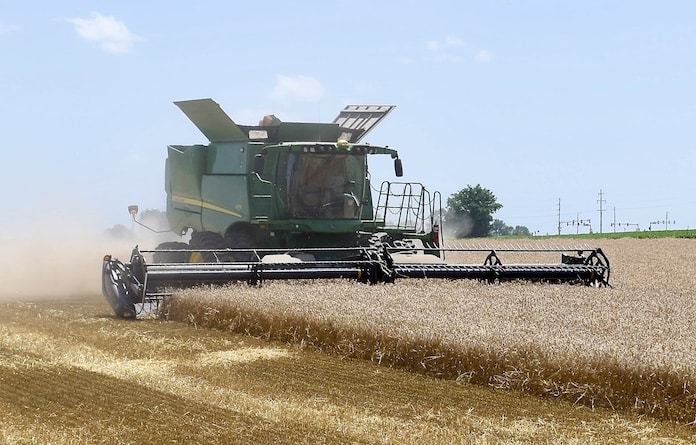Wheat leaves farmers wanting

Fields around Monroe County have been busy over the past few weeks, with the recent dry spell in particular allowing local farmers to enjoy a successful wheat harvest – even if the market leaves little for them to celebrate.
Gateway FS Grain Originator Michael Biethman offered a generally positive assessment of the area wheat harvest, though even nearby farmers to the south have felt the impact of troublesome spring weather.
“Going in, we were holding our breath because it was very wet, and whenever wheat gets wet, there can be quality issues,” Biethman said. “Specifically to Monroe County, I think it made it through the weather OK. There were some wet spots, but Monroe County didn’t have or seem to have near the downed wheat problem that Randolph County had.”
Farmers in Monroe County, per Biethman, have reported good quality wheat, though it ranks just short of the quality from last year’s harvest.
With a fair test weight, he added that he has not heard from many farmers who have hit 100 bushels per acre. While that was fairly common last year, that seems to be, as he said, the exception rather than the rule this summer.
The biggest issue farmers are set to face now that the grain has been harvested is the price.
“On the back side, we were holding our breath going in, and I would say all the knocking on wood, it worked,” Biethman said. “Quality was OK in Monroe County. It was a good wheat harvest overall, I’d say, other than the price… Basically as soon as combines started rolling in Monroe County, the futures market turned around, and it went down and we lost 50 cents on the price of wheat.”
Biethman spoke further on the market difficulties farmers are set to face as they sell their wheat, with a decent harvest and poor prices likely covering costs and not leaving much in the way of profits.
“There’s a difference between $5.50 wheat and $5 wheat, and honestly we went below $5 cash wheat for a while,” Biethman said. “That is the worst element of this because guys did grow a decent, decent crop. I wouldn’t call it great or a record, but I’d call it decent. Poor prices, that’s what puts a sour mood on this wheat harvest.”
Biethman also spoke to a few other goings-on in the fields for the summer, remarking on the especially wet April pushing corn and soybean planting back by quite a lot, compounded by rain that continued to fall in May.
Storms and hail – particularly to the south – also didn’t help.
The recent dry weather – though painfully hot last week – allowed for both a decent wheat harvest and subsequent planting of double crop soybeans.
Speaking further on the weather, Biethman noted corn is all over the place in Monroe County, with some fields down in the bottoms already tasseling or preparing to since they were planted in March and other corn just coming out of the ground as it was planted a few weeks ago.
Looking to the future, farmers will be reliant on Mother Nature as always to give them the weather they need when they need it.
“We still need rain,” Biethman said. “We definitely need rain going forward, whether that’s to fill the kernels for the corn that has already been pollinated or the corn that has just been planted a couple weeks ago, and it needs rain to shoot up and reach that maturity. Then we’re gonna be looking for rain toward the end of July. A lot of your corn is gonna be tasseling at the end of July along with full-season beans really needing a drink to fill them out as well.”
With Biethman offering a bird’s-eye view, several area farmers spoke to their personal experience with the recent harvest, voicing similar sentiments.
Down in the bottoms, Bruce Brinkman said he was fairly concerned a few months ago given all the rain, though things seem to have turned out OK for this summer’s wheat harvest.
“Harvest is pretty much wrapped up for the most part,” Brinkman said. “It was a pretty good year. Crop was above average. I haven’t taken anything to the elevator, so I don’t know what my test weights are, but the yields were good, pretty decent. A little later than normal.”
While the yields are looking good, Brinkman added that all those bushels are gonna be needed to make up the difference given prices.
“Even with the yields being above average, the price has been pretty brutal,” Brinkman said. “The price could be a buck and a half higher, and it would help out a whole bunch a bushel, but it’s not there, so we’ll have to go from there. The cash price is pretty depressing, to say the least. It takes a lot of bushels to cover the price difference with the input cost. So, not to be all doom-and-gloom, but it just makes it pretty challenging. It’s gonna cover costs, but that’s about all it’s gonna do. We’ll be having hot dogs and not ribeyes.”
Steve Degener, with property around Waterloo, offered a similar assessment regarding the strong state of his yields and test weights, tempered by mediocre prices.
He also commented on how the weather these past few months has managed to put his acreage behind.
“The rain through May was just not good, April and May,” Degener said. “I waited around Easter for that five-inch rain, which I probably shouldn’t have, and then it rained for a month and a half. Everybody’s just playing catch-up all year, and there are still people planting first-crop beans, not around here but around the area. It’s been a challenging spring.”
Toward Hecker, Jeremy Neff reported a good harvest with little rain delays, his yields coming in around 90-110 bushels per acre with test weight over 60 pounds.
“For all the rain that we had this spring, I was very happy with the yields and quality of the wheat,” Neff said. “We did spray a fungicide, and I think that helped.”
Singing the same tune, Neff also bemoaned current wheat prices, further remarking that the current state of wheat might mean he won’t be planting any to harvest this time next year.
“Prices, we’re looking at that right now, even contemplating growing wheat next year, planting this fall because of the price of wheat, how it’s dropped,” Neff said. “We had some contract at $6, and now you can only get $5.30 for it. With the lower wheat prices, we needed the good yield to cover our input costs. If we had an average wheat crop, we would’ve lost money. Definitely happy with the yield, because it made up for things.”






